Retrieved from https://studentshare.org/journalism-communication/1559350-digital-media-and-society-blog-how-is-information-a-public-good-in-the-media-profession
https://studentshare.org/journalism-communication/1559350-digital-media-and-society-blog-how-is-information-a-public-good-in-the-media-profession.


